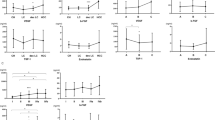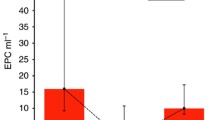Abstract
Background
Circulating angiogenic factors in patients with colorectal cancer liver metastases may promote tumor growth and contribute to liver regeneration after partial hepatectomy.
Methods
We analyzed blood samples from 26 patients with colorectal cancer liver metastases before and after liver resection and used samples from 20 healthy controls as a reference. Plasma levels of vascular endothelial growth factor (VEGF), basic fibroblast growth factor (bFGF), epidermal growth factor (EGF), and hepatocyte growth factor (HGF) were measured, and levels were correlated with recurrence.
Results
The median preoperative levels of all four factors were significantly higher and more variable in colorectal cancer liver metastasis patients than in controls. HGF and bFGF levels increased significantly 3 days and 1 month after hepatectomy, respectively, and returned to near preoperative levels at 3 months. Postoperative VEGF and EGF levels remained relatively stably increased over 3 months. After a median follow-up of 19 months, 10 patients (42%) experienced recurrence. Higher preoperative VEGF and HGF levels correlated with subsequent recurrence (P = .018 and .021, respectively), and a preoperative adjusted total value of all four factors accurately identified patients at low, moderate, and high risk of recurrence (P = .034). Patients who experienced disease recurrence also had relatively higher bFGF levels 3 months after operation (P = .035).
Conclusions
Plasma angiogenic factors are increased in patients with colorectal cancer liver metastases and remain increased at least 3 months after partial hepatectomy. Measurement of certain factors before and after hepatic resection can predict recurrence. Targeted biological agents may counteract the tumor-promoting effects of these circulating factors on subclinical disease.





Similar content being viewed by others
References
Jemal A, Murray T, Ward E, et al. Cancer statistics. 2005 CA Cancer J Clin 55:10–30
Weiss L, Grundmann E, Torhorst J, et al. Haematogenous metastatic patterns in colonic carcinoma: an analysis of 1541 necropsies. J Pathol 1986;150:195–203
Ballantyne GH, Quin J. Surgical treatment of liver metastases in patients with colorectal cancer. Cancer 1993;71:4252–66
Folkman J. Tumor angiogenesis: therapeutic implications. N Engl J Med 1971;285:1182–6
Hanahan D, Folkman J. Patterns, emerging mechanisms of the angiogenic switch during tumorigenesis. Cell 1996;86:353–64
Cross MJ, Claesson-Welsh L. FGF, VEGF function in angiogenesis: signalling pathways, biological responses and therapeutic inhibition. Trends Pharmacol Sci 2001;22:201–7
Dvorak HF. Vascular permeability factor/vascular endothelial growth factor: a critical cytokine in tumor angiogenesis, a potential target for diagnosis and therapy. J Clin Oncol 2002;20:4368–80
Shing Y, Folkman J, Sullivan R, Butterfield C, Murray J, Klagsbrun M. Heparin affinity: purification of a tumor-derived capillary endothelial cell growth factor. Science 1984;223:1296–9
Poon RT, Fan ST, Wong J. Clinical implications of circulating angiogenic factors in cancer patients. J Clin Oncol 2001;19:1207–1225
Yoon SS, Tanabe KK. Surgical treatment, other regional treatments for colorectal cancer liver metastases. Oncologist 1999;4:197–208
Choti MA, Sitzmann JV, Tiburi MF, et al. Trends in long-term survival following liver resection for hepatic colorectal metastases. Ann Surg 2002;235:759–66
Jarnagin WR, Gonen M, Fong Y, et al. Improvement in perioperative outcome after hepatic resection: analysis of 1,803 consecutive cases over the past decade. Ann Surg 2002;236:397–406
Koniaris LG, McKillop IH, Schwartz SI, Zimmers TA. Liver regeneration. J Am Coll Surg 2003;197:634–59
Weglarz TC, Sandgren EP. Timing of hepatocyte entry into DNA synthesis after partial hepatectomy is cell autonomous. Proc Natl Acad Sci U S A 2000;97:12595–600
Chen MF, Hwang TL, Hung CF. Human liver regeneration after major hepatectomy. A study of liver volume by computed tomography. Ann Surg 1991;213:227–9
Court FG, Wemyss-Holden SA, Dennison AR, Maddern GJ. The mystery of liver regeneration. Br J Surg 2002;89:1089–95
Schmidt C, Bladt F, Goedecke S, et al. Scatter factor/hepatocyte growth factor is essential for liver development. Nature 1995;373:699–702
Jones DE Jr, Tran-Patterson R, Cui DM, Davin D, Estell KP, Miller DM. Epidermal growth factor secreted from the salivary gland is necessary for liver regeneration. Am J Physiol 1995;268:G872–78
Funakoshi H, Nakamura T. Hepatocyte growth factor: from diagnosis to clinical applications. Clin Chim Acta 2003;327:1–23
Morishita R, Aoki M, Hashiya N, et al. Therapeutic angiogenesis using hepatocyte growth factor (HGF). Curr Gene Ther 2004;4:199–206
Bruns CJ, Solorzano CC, Harbison MT, et al. Blockade of the epidermal growth factor receptor signaling by a novel tyrosine kinase inhibitor leads to apoptosis of endothelial cells and therapy of human pancreatic carcinoma. Cancer Res 2000;60:2926–35
Ross MA, Sander CM, Kleeb TB, Watkins SC, Stolz DB. Spatiotemporal expression of angiogenesis growth factor receptors during the revascularization of regenerating rat liver. Hepatology 2001;34:1135–48
Kaplan E, Meier P. Nonparametric estimation from incomplete observations. J Am Stat Assoc 1958;53:457–481
Davies MM, Jonas SK, Kaur S, Allen-Mersh TG. Plasma vascular endothelial but not fibroblast growth factor levels correlate with colorectal liver metastasis vascularity, volume. Br J Cancer 2000;82:1004–8
Dirix LY, Vermeulen PB, Hubens G, et al. Serum basic fibroblast growth factor and vascular endothelial growth factor and tumour growth kinetics in advanced colorectal cancer. Ann Oncol 1996;7:843–848
Fujisaki K, Mitsuyama K, Toyonaga A, Matsuo K, Tanikawa K. Circulating vascular endothelial growth factor in patients with colorectal cancer. Am J Gastroenterol 1998;93:249–52
Hyodo I, Doi T, Endo H, et al. Clinical significance of plasma vascular endothelial growth factor in gastrointestinal cancer. Eur J Cancer 1998;34:2041–2045
Landriscina M, Cassano A, Ratto C, et al. Quantitative analysis of basic fibroblast growth factor and vascular endothelial growth factor in human colorectal cancer. Br J Cancer 1998;78:765–70
Dirix LY, Vermeulen PB, Pawinski A, et al. Elevated levels of the angiogenic cytokines basic fibroblast growth factor and vascular endothelial growth factor in sera of cancer patients. Br J Cancer 1997;76:238–243
Fukuura T, Miki C, Inoue T, Matsumoto K, Suzuki H. Serum hepatocyte growth factor as an index of disease status of patients with colorectal carcinoma. Br J Cancer 1998;78:454–459
Fong Y, Fortner J, Sun RL, Brennan MF, Blumgart LH. Clinical score for predicting recurrence after hepatic resection for metastatic colorectal cancer: analysis of 1001 consecutive cases. Ann Surg 1999;230:309–18
Kaneko A, Hayashi N, Tanaka Y, et al. Changes in serum human hepatocyte growth factor levels after transcatheter arterial embolization and partial hepatectomy. Am J Gastroenterol 1992;87:1014–17
Shiota G, Okano J, Kawasaki H, Kawamoto T, Nakamura T. Serum hepatocyte growth factor levels in liver diseases: clinical implications. Hepatology 1995;21:106–112
Curley SA, Izzo F, Abdalla E, Vauthey JN. Surgical treatment of colorectal cancer metastasis. Cancer Metastasis Rev 2004;23:165–82
Ellis LM, Liu W, Ahmad SA, et al. Overview of angiogenesis: biologic implications for antiangiogenic therapy. Semin Oncol 2001;28:94–104
Hurwitz H, Fehrenbacher L, Novotny W, et al. Bevacizumab plus irinotecan, fluorouracil, and leucovorin for metastatic colorectal cancer. N Engl J Med 2004;350:2335–42
Kabbinavar F, Hurwitz HI, Fehrenbacher L, et al. Phase II, randomized trial comparing bevacizumab plus fluorouracil (FU)/leucovorin (LV) with FU/LV alone in patients with metastatic colorectal cancer. J Clin Oncol 2003;21:60–5
Saltz LB, Meropol NJ, Loehrer PJ Sr, Needle MN, Kopit J, Mayer RJ. Phase II trial of cetuximab in patients with refractory colorectal cancer that expresses the epidermal growth factor receptor. J Clin Oncol 2004;22:1201–8
Cunningham D, Humblet Y, Siena S, et al. Cetuximab monotherapy and cetuximab plus irinotecan in irinotecan-refractory metastatic colorectal cancer. N Engl J Med 2004;351:337–45
Saltz LB, Lenz H, Kindler H, et al. Interim report of randomized phase II trial of cetuximab/bevacizumab/irinotecan (CBI) versus cetuximab/bevacizumab (CB) in irinotecan-refractory colorectal cancer (abstract). ASCO Gastrointestinal Cancers Symposium. 2005
Acknowledgments
Supported by National Institutes of Health grant K12CA87723-02 (S.S.Y.) and CA94503 (R.P.D.). The authors thank Rachel Jacobi, Beata Korytowski, and Brenda Guilfoyle for assistance with blood specimen collection and Sandra Ryeom, PhD for reviewing the manuscript.
Author information
Authors and Affiliations
Corresponding author
Rights and permissions
About this article
Cite this article
Yoon, S.S., Kim, S.H., Gonen, M. et al. Profile of Plasma Angiogenic Factors Before and After Hepatectomy for Colorectal Cancer Liver Metastases. Ann Surg Oncol 13, 353–362 (2006). https://doi.org/10.1245/ASO.2006.03.060
Received:
Accepted:
Published:
Issue Date:
DOI: https://doi.org/10.1245/ASO.2006.03.060




